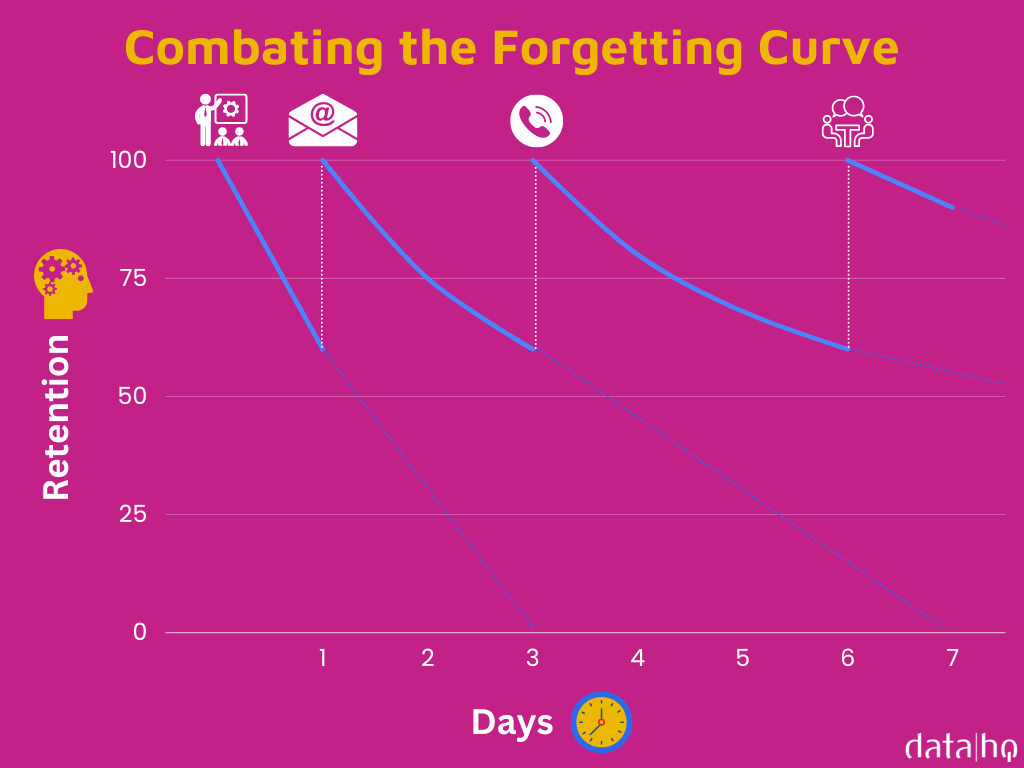
By Carlene Russell 4 min read

#DataHQIDEAS
It can feel really exciting when everyone gets behind your marketing plan at the launch.
But how do you keep that momentum when your colleagues have the pressures of their own day jobs to juggle?
A little lesson from German psychologist Hermann Ebbinghaus might just provide the insight you need.
Ebbinghaus wanted to understand more about why we forget things and how to prevent it.
His research produced the Forgetting Curve – a visual representation of the way that learned information fades over time.
Whilst your marketing plan is important to you, the scary fact is that people will probably forget 60% of what you just shared within the first 20 minutes, and 90% within the first week - unless you make intentional attempts to refresh it.

Here’s the key points:
- Memories weaken over time. If we learn something new, but then make no attempt to relearn that information, we remember less and less of it as the hours, days and weeks go by.
- The biggest drop in retention happens soon after learning. This is reflected by the steep fall at the start of the Forgetting Curve. They may leave your presentation with their heads full of new facts and figures, only to find that they can’t remember very much of it just hours later.
- It's easier to remember things that have meaning. If you're listening to a talk on a subject that you don't really understand or have little interest in, you'll likely forget it faster than if it were on a subject that you found really engaging.
- The way something is presented affects retention. The same set of information can be made more or less memorable, depending on how well it's communicated.
- How you feel affects how well you remember. Ebbinghaus believed that physiological factors, such as stress and sleep, play a significant part in how well we retain information. When is the best time for your stakeholders to have space to hear your message?
Here’s 4 tips on how you can help keep engagement with your marketing plan high:
- Use "Spaced Refreshes"
Timing is everything. Now you know when the most information is lost, plan your communication to include timely reviews to improve retention and buy in. A review session soon after the initial presentation halts the forgetting curve and although forgetting starts again after each review session, it's slower than before. That's why each new curve shown in the below chart is shallower than the last.
- Overlearn
When Ebbinghaus was thinking about this, he was thinking about study environments. He suggested that putting in more than the usual amount of effort when you learn something improved retention, and slowed the steep drop seen on the Forgetting Curve. So how can you relate this overlearning experience for your colleagues when you present your marketing plan? Think about this concept when you put your material together and consider the mode of delivery. How can you create a stand-out moment for them that will be more memorable and involve them to make the process one which could be akin to ‘overlearning’. Which leads me nicely on to my next point. - Make your presentation and spaced refreshers interactive
Broadcasting your presentation ‘at’ your audience most definitely won’t help. We’ve all been secretly glad to go to meetings when we can just ‘sit back and listen’ and we’re not required to do anything – it doesn’t usually mean we’re that engaged. Think about presenting alongside stakeholders from other parts of the business that matter to people in the room. Give listeners choice over which parts of the plan they drill in to either on the day or for their personal refresher session, use meeting tools to run mini votes, get live feedback, or invite the audience to do the closing recap for you by gamifying the building blocks and asking them to put them together in the right place. - Make the information relevant, long lasting and visually appealing
These days, threre are clever ways to create the blocks of a meaningful plan. For example, a digital TAM report (Target Addressable Market) is a living dashboard with engaging succinct visuals that can be used by your business leaders to predict the spend in your target market and match this against your current sales performance revealing opportunities for new business and growth. Because the dashboard is designed to be used for sales planning, it brings the plan to life on a day-to-day basis as sales teams dig around in their territories to see where to focus. The dashboard gives you a longer lasting opportunity to communicate your key messages each time someone opens it, whilst also giving your stakeholders the power and control to drill down into precisely what’s relevant and helpful to them. And because digital TAM’s can be licensed for a period of 6 months for example, if something in your market-place changes to make a sector or geography more or less attractive then the data automatically updates.
I hope this was useful. If you’re building relationships with stakeholders in your team then this might also be an interesting read.
Carlene Russell
Data HQ Senior Account Manager
You can email me if you need some help
Connect with me on LinkedIN for more #DataHQIDEAS
Related blogs and ideas
Explore more ideas
Let us open your mind to new possibilities
Our stories and ideas direct to your inbox





